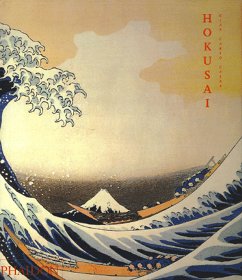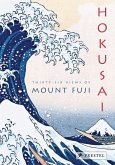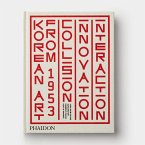This big and beautiful book presents a comprehensive survey of the work of one of Japan's greatest and most influential artists, together with a collection of essays that focus on a key aspects of the master's career. The book opens with an introductory essay by Gian Carlo Calza presenting an overview of the changing world into which Hokusai was born and through which he lived. This is followed by a series of essays, composed by distinguished Western and Japanese scholars, that present new research on a range of crucial areas of interest in Hokusai studies.
These form a context for the core of the book, which embodies a retrospective of Hokusai's entire career, divided into seven chapters. Each chapter provides a succinct account of a phase in Hokusai's life, followed by a series of the finest and most representative works of that period. Great care has been taken throughout to choose for reproduction the best-preserved original prints that reveal Hokusai's mastery ofline and colour to full advantage.
This magnificent pictorial survey of Hokusai's prints, paintings and drawings is the first publication in English to make such a rich selection widely available, and to demonstrate the extraordinary range and quality of Hokusai's achievement. The final component of the book is a detailed scholarly commentary on each illustration that provides not only the necessary technical information but also a revealing analysis of style, color, composition and motif.
These form a context for the core of the book, which embodies a retrospective of Hokusai's entire career, divided into seven chapters. Each chapter provides a succinct account of a phase in Hokusai's life, followed by a series of the finest and most representative works of that period. Great care has been taken throughout to choose for reproduction the best-preserved original prints that reveal Hokusai's mastery ofline and colour to full advantage.
This magnificent pictorial survey of Hokusai's prints, paintings and drawings is the first publication in English to make such a rich selection widely available, and to demonstrate the extraordinary range and quality of Hokusai's achievement. The final component of the book is a detailed scholarly commentary on each illustration that provides not only the necessary technical information but also a revealing analysis of style, color, composition and motif.
"This beautiful monograph, a seriously weighty tome, not only provides a comprehensive overview of Hokusai's work but also analyses his influence on Western artists. Immaculately reproduced artwork combined with research from both Western and Japanese scholars as well as intelligent commentary accompanying each of the amazing illustrations make this book worth every last penny."-Creative Review
"Gives us a true idea of the great range of Hokusai's work and its enormous variety... The finest of the new publications on Hokusai."-Donald Richie, The Japan Times
"As the hundreds of plates in this book attest, Hokusai's work has a breadth and versatility that might surprise those who know the artist principally for those seemingly endless depictions of Tokyo's celebrated conical volcano."-World of Interiors
"Comprehensive and splendidly illustrated... It is such a visually stimulating read that this has to be the art book I would most like to find under the Christmas tree."-Frank Whitford, The Sunday Times, November
"Superb reproductions make this probably the best introduction to this artist you can find."-Wall Street Journal Europe
"Great care has been taken throughout to choose for reproduction the best preserved original prints that reveal Hokusai's mastery of line and colour to full advantage... A must for the library of anyone interested in Japanese art, and once again Phaidon must be praised for publishing another artist's work in such detail."-County Times
"Gives us a true idea of the great range of Hokusai's work and its enormous variety... The finest of the new publications on Hokusai."-Donald Richie, The Japan Times
"As the hundreds of plates in this book attest, Hokusai's work has a breadth and versatility that might surprise those who know the artist principally for those seemingly endless depictions of Tokyo's celebrated conical volcano."-World of Interiors
"Comprehensive and splendidly illustrated... It is such a visually stimulating read that this has to be the art book I would most like to find under the Christmas tree."-Frank Whitford, The Sunday Times, November
"Superb reproductions make this probably the best introduction to this artist you can find."-Wall Street Journal Europe
"Great care has been taken throughout to choose for reproduction the best preserved original prints that reveal Hokusai's mastery of line and colour to full advantage... A must for the library of anyone interested in Japanese art, and once again Phaidon must be praised for publishing another artist's work in such detail."-County Times



